Dive into the world of Korean fermented foods and discover their health benefits and unique flavors. Start exploring now!
Exploring the Rich World of Korean Fermented Foods: Beyond Kimchi
Introduction
Korean cuisine is a treasure trove of flavors and traditions, with fermented foods playing a pivotal role in its culinary landscape. While kimchi is the most renowned Korean fermented food, the world of Korean fermentation extends far beyond, offering a diverse array of flavors, textures, and health benefits. In this comprehensive guide, we delve into the lesser-known yet equally fascinating Korean fermented foods, exploring their origins, preparation methods, and cultural significance.
The Cultural Significance of Fermented Foods in Korea
Fermented foods are deeply embedded in Korean culture, reflecting centuries of culinary tradition and ingenuity. These foods were originally developed as a means of preservation, allowing ingredients to be stored and consumed throughout the harsh winters. Over time, fermentation techniques evolved, and these foods became central to Korean dietary habits and cultural practices.
Historical Background
The practice of fermentation in Korea dates back over two thousand years, with historical records from the Three Kingdoms period (57 BCE – 668 CE) documenting the use of fermented foods. These ancient practices have been refined over generations, contributing to the rich and diverse palate of Korean cuisine today.
Types of Korean Fermented Foods
Kimchi: The Iconic Staple
Kimchi, the fiery fermented cabbage, is Korea’s most famous culinary export. It comes in numerous varieties, each with its unique flavor profile and preparation method.
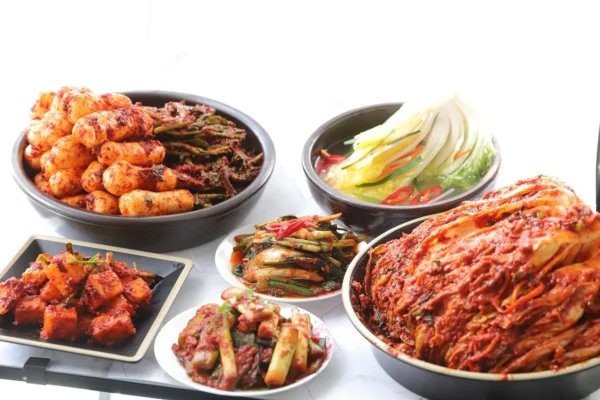
Baechu (Napa Cabbage) Kimchi
Baechu kimchi is the most traditional form, made with napa cabbage, garlic, ginger, gochugaru (Korean chili powder), and jeotgal (salted seafood). The fermentation process can last from a few days to several weeks, resulting in a tangy, spicy dish rich in probiotics.
Kkakdugi (Radish) Kimchi
Kkakdugi is a type of kimchi made from diced radish. Its crisp texture and slightly sweet flavor make it a popular accompaniment to hearty Korean meals.
Baek (White) Kimchi
Baek kimchi is a milder, non-spicy version that uses napa cabbage and a brine of salt, ginger, garlic, and sometimes fruits like pear or chestnut, resulting in a refreshing and subtly flavored dish.

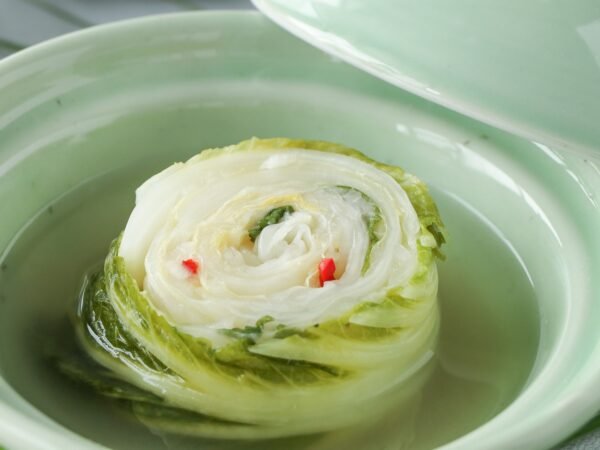

Fermented Soy Products
Doenjang (Soybean Paste)
Doenjang is a thick, brown paste made from fermented soybeans. It is a staple ingredient in many Korean dishes, known for its deep umami flavor. Doenjang is often used in soups, stews, and as a marinade.
Ganjang (Soy Sauce)
Ganjang, or Korean soy sauce, is a byproduct of doenjang fermentation. It is lighter and saltier than Japanese soy sauce, with a distinct flavor that enhances various Korean dishes.
Gochujang (Chili Paste)
Gochujang is a spicy-sweet red chili paste made from fermented soybeans, glutinous rice, and chili powder. It is a key ingredient in many Korean recipes, adding heat and depth to dishes.
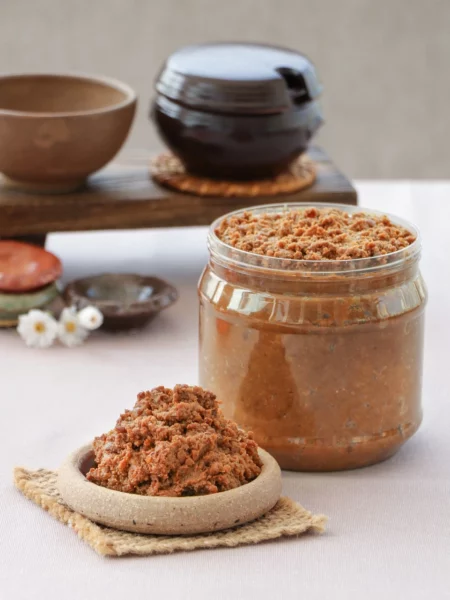

 pixabay
pixabay

Fermented Seafood
Jeotgal (Salted Seafood)
Jeotgal refers to various types of salted and fermented seafood, including fish, shrimp, and shellfish. It is used as a condiment and flavor enhancer in numerous Korean dishes.
Saeu-jeot (Salted Shrimp)
Saeu-jeot is a popular type of jeotgal made from small, salted shrimp. It is commonly used in kimchi preparation and to season soups and stews.
Fermented Grains
Makgeolli (Rice Wine)
Makgeolli is a traditional Korean alcoholic beverage made from fermented rice. It has a milky appearance and a slightly sweet, tangy flavor. Often enjoyed in social settings, makgeolli is celebrated for its refreshing taste and relatively low alcohol content.
Nuruk (Fermentation Starter)
Nuruk is a fermentation starter made from grains. It is essential for the production of various Korean alcoholic beverages, including makgeolli and soju. Nuruk contains natural yeasts and enzymes that initiate the fermentation process.
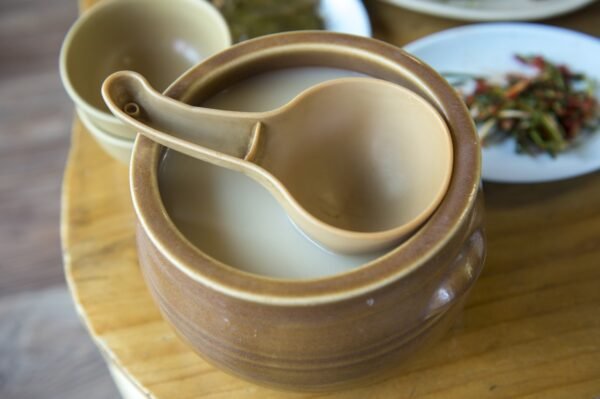
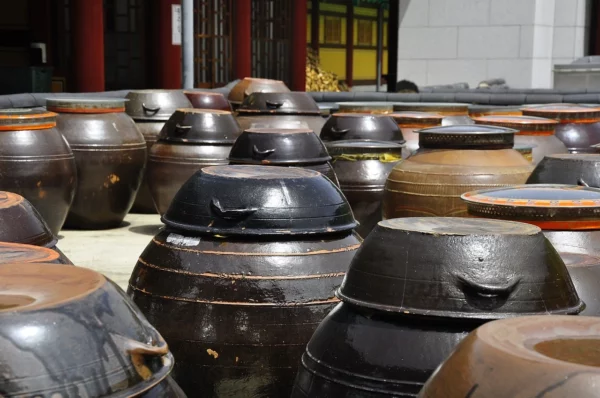
Health Benefits of Korean Fermented Foods
Probiotics and Gut Health
Korean fermented foods are rich in probiotics, beneficial bacteria that support a healthy digestive system. Regular consumption can improve gut health, enhance nutrient absorption, and boost the immune system.
Nutritional Advantages
Fermented foods are nutrient-dense, providing essential vitamins, minerals, and amino acids. The fermentation process increases the bioavailability of these nutrients, making them easier for the body to absorb.
Antioxidant Properties
Many Korean fermented foods contain high levels of antioxidants, which help combat oxidative stress and reduce the risk of chronic diseases.
Anti-inflammatory Effects
Fermented foods have been shown to have anti-inflammatory properties, which can help manage inflammation-related conditions such as arthritis and cardiovascular diseases.
Traditional and Modern Preparation Methods
Traditional Fermentation Techniques
Traditional Korean fermentation techniques involve natural processes and the use of specific earthenware jars called onggi. These jars allow for optimal air circulation and temperature regulation, essential for successful fermentation.
Modern Adaptations
Modern fermentation methods often incorporate refrigeration and controlled environments to ensure consistency and safety. These adaptations allow for year-round production and help maintain the quality of fermented foods.
Key Ingredients and Their Roles
Key ingredients in Korean fermentation include salt, gochugaru, garlic, ginger, and various types of seafood. Each ingredient plays a crucial role in the development of flavor, texture, and preservation of the food.
Signs of Successful Fermentation
Visual Indicators
Successful fermentation is often indicated by changes in color and texture. For instance, kimchi should appear vibrant and slightly translucent, with visible bubbles indicating active fermentation.
Olfactory Indicators
A pleasant, tangy aroma is a good sign of successful fermentation. An off-putting or foul smell can indicate spoilage or improper fermentation.
Taste Markers
The taste of properly fermented foods should be balanced, with a combination of tanginess, saltiness, and umami. Overly sour or bitter flavors may signal fermentation issues.
Common Issues and Troubleshooting
Environmental Factors
Temperature and humidity are critical factors in fermentation. Too high or too low temperatures can disrupt the process and lead to spoilage.
Ingredient Quality
The quality of ingredients used in fermentation affects the final product. Fresh, high-quality ingredients are essential for successful fermentation.
Common Mistakes
Common mistakes include incorrect salt ratios, poor hygiene practices, and inadequate temperature control. Troubleshooting involves adjusting these factors to achieve the desired outcome.
Diagnostic Tools for Fermented Foods
pH Testing
pH testing can help determine the acidity level of fermented foods, crucial for both flavor and safety. A pH of 4.6 or lower is typically considered safe for consumption.
Microbial Analysis
Microbial analysis can identify the types and quantities of bacteria present in fermented foods, ensuring they contain beneficial probiotics and are free from harmful pathogens.
Sensory Evaluation
Sensory evaluation involves using sight, smell, and taste to assess the quality of fermented foods. This method, while subjective, provides valuable insights into the fermentation process.
Treatment and Preventive Measures
Adjusting Fermentation Conditions
Modifying temperature, humidity, and duration can help resolve fermentation issues and improve the quality of the final product.
Ingredient Substitutions
Substituting ingredients, such as using different types of salt or alternative spices, can address flavor or texture problems in fermented foods.
Hygiene Practices
Maintaining cleanliness and hygiene throughout the fermentation process is crucial. This includes sterilizing equipment and washing hands thoroughly.
Proper Storage
Fermented foods should be stored in cool, dark places to prevent spoilage and prolong shelf life. Refrigeration can also help maintain the quality of the food.
Personal Stories and Case Studies
Traditional Family Recipes
Many Korean families have passed down fermentation recipes through generations, each adding their unique touch. These stories highlight the cultural significance and personal connections to fermented foods.
Modern Fermentation Experiments
Enthusiasts and chefs around the world experiment with Korean fermentation techniques, creating innovative dishes that blend tradition with modern culinary practices.
Success Stories and Lessons Learned
Sharing success stories and lessons learned from fermentation experiences can inspire others to explore this fascinating culinary art.
Expert Insights
Quotes from Fermentation Experts
Experts in the field of fermentation offer valuable insights and tips for achieving the best results. Their knowledge can help both beginners and experienced fermenters.
Professional Advice on Best Practices
Professional advice on best practices, including the use of specific tools and techniques, can enhance the quality and safety of fermented foods.
Predictions for the Future of Fermentation
Experts predict that the future of fermentation will see more innovation and experimentation, with a focus on health benefits and sustainable practices.
Conclusion
Korean fermented foods offer a rich tapestry of flavors, health benefits, and cultural significance. By understanding the types, health benefits, preparation methods, and troubleshooting techniques, you can master the art of fermentation and create delicious, nutritious dishes. We encourage you to explore this culinary tradition, share your experiences, and contribute to the growing community of fermentation enthusiasts.
A[Traditional Fermentation Techniques] --> B[Natural Processes]
B --> C[Use of Onggi Jars]
A --> D[Modern Adaptations]
D --> E[Refrigeration]
D --> F[Controlled Environments]
E --> G[Year-round Production]
F --> H[Quality Maintenance]
B --> I[Optimal Air Circulation]
C --> J[Temperature Regulation]김치를 넘어서: 한국 발효 음식의 맛있는 여행 – 전통의 맛과 건강 효과
안녕하세요, 여러분! 오늘도 흥미진진한 한국 전통 음식에 대한 주제로 찾아왔어요. 바로 한국의 발효 음식에 대해 이야기해볼 건데요. 김치만 들어보셨다구요? 아니에요, 한국 발효 음식의 세계는 그보다 훨씬 더 넓고 깊답니다!
🥬 김치, 그 너머의 세계
김치가 한국 발효 음식의 대표주자인 건 맞아요. 하지만 여러분, 김치에도 여러 종류가 있다는 거 알고 계셨나요?
1. 배추김치: 가장 흔히 볼 수 있는 김치예요. 매콤하고 시원한 맛이 일품!
2. 깍두기: 아삭아삭한 무로 만든 김치. 든든한 식사와 찰떡궁합이에요.
3. 백김치: 매운 걸 못 드시는 분들을 위한 김치. 상큼하고 깔끔한 맛이 특징이에요.
🫘 콩으로 만든 발효 식품들
된장, 간장, 고추장… 이름만 들어도 침이 고이지 않나요? 이 모든 게 다 콩으로 만든 발효 식품이에요!
1. 된장: 깊은 맛의 비결, 찌개에 넣으면 정말 맛있어요.
2. 간장: 된장 만들 때 나오는 부산물인데, 이게 또 맛있다니까요!
3. 고추장: 매콤달콤한 맛의 대명사, 비빔밥에 한 숟가락이면 천국이 따로 없죠.
🐟 바다의 선물, 발효 해산물
젓갈 들어보셨나요? 새우젓, 멸치젓 등 다양한 젓갈이 한국 요리의 감칠맛을 더해줘요. 김치 담글 때 꼭 들어가는 재료이기도 하답니다.
🍶 술도 발효식품이라고요?
맞아요! 막걸리가 대표적인 한국의 발효주예요. 약간 달콤하고 새콤한 맛이 나는데, 마시다 보면 어느새 한 주전자가 비어있더라고요. (물론 과하게 드시면 안 돼요!)
🧬 발효식품의 건강 효과
여러분, 이런 발효식품들이 건강에 정말 좋다는 거 알고 계셨나요?
1. 장 건강에 최고예요. 프로바이오틱스가 가득하거든요!
2. 영양소가 풍부해요. 발효 과정에서 영양소가 더 잘 흡수되는 형태로 바뀌거든요.
3. 항산화 효과도 있어요. 노화 방지에 도움이 된답니다.
4. 염증을 줄여주는 효과도 있어요. 관절염이나 심혈관 질환 예방에 좋대요.
자, 어떠세요? 한국의 발효 음식 세계가 정말 흥미진진하지 않나요? 여러분도 한번 직접 만들어보는 건 어떨까요? 된장찌개 한 그릇이면 추운 날씨도 문제없어요!
다음에는 발효 음식 만드는 법에 대해 자세히 알아볼게요. 여러분도 맛있는 한국의 발효 음식 드시고 건강하세요~ 😊🥢
